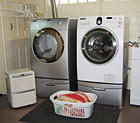
Portable, electric units are often used in basements and can also be effective when used in areas where a lot of humidity is released, such as laundry rooms and kitchens.
Mold, mildew, and dust mites are common biological contaminants inside homes, and there is one dominating common factor: moisture. Not only does moisture foster mold, mildew, and dust mites, but there are also some viruses and bacteria that can circulate through a home’s ventilation system, especially if moisture is present.
There’s not one simple moisture answer to every home and every locale, but there are a variety of options worth considering at all price points, especially in light of the health benefits that can result from controlling humidity within the home.
WHOLE-HOME SOLUTIONS
Environmental experts report that mold spores must have water or moisture to reproduce, and dust mites thrive in moist conditions. Consequently, controlling moisture levels in the home is key to controlling these pollutants. Most experts recommend keeping the relative humidity inside the home at 50 percent or less. In nearly all areas, that means some kind of dehumidification is needed.There are several ways to approach this issue, but many people rely on their central a/c systems for dehumidification. Dehumidification is one of the functions of air conditioning; however, as condensing units become increasingly efficient, the dehumidification function may suffer. With tighter construction and greater efficiency, the a/c may not operate long enough to adequately remove excess moisture.
As a result, it is not uncommon for residents to feel uncomfortable and sticky because the humidity is too high. Humidity is a critical factor in comfort, affecting the body’s natural ability to regulate temperature. Because of this, some homeowners turn down the thermostat in an attempt to be more comfortable. Since cold air holds less moisture than warm air, the relative humidity may actually increase, as evidenced by condensation on surfaces.
Overall, one of the single most effective measures for controlling this excess moisture is adding a whole-house dehumidifier. It keeps the entire home at the desired humidity level because this type of equipment is connected to the central air conditioning system ductwork.
The homeowner sets the humidity level at the most comfortable setting and the unit turns on to remove moisture when it senses excess humidity. The Comfort-Aire WHD whole-house dehumidifier, for instance, works by sampling air from the home for 15 minutes every hour. This ensures that every room in the home is kept at its preset level.
DRYING TACTICS
The whole-house unit isn’t the only way to approach dehumidification, however, and it is important to remember that not all homes have central air conditioning. While a whole-house dehumidifier is especially suited to areas of constant high humidity and to larger homes, in certain areas and in smaller dwellings, a portable dehumidifier may provide adequate moisture removal.Portable electric units are often used in basements, lowering the humidity level throughout the home by controlling the dampness in that lower level. A portable unit can also be effective when used in areas where a lot of humidity is released, such as laundry rooms and kitchens. Many of today’s portable models have controls for setting the desired humidity level, and sensors to turn the compressor on and off as the humidity level changes.
Another approach to dehumidification is the installation of variable-speed/multi-stage equipment. For instance, Comfort-Aire’s “V” Series ductless mini-splits maximize comfort with inverter technology. The inverter varies the frequency of the power going to the compressor so it can match the power with the demand. Once the thermostat is satisfied, the compressor slows to a low speed to maintain the temperature, ramping up if the demand changes.
In a traditional system, when the compressor cycles off in the cooling mode, dehumidification also stops. With the inverter system, however, excess moisture in the air is removed continuously because the unit runs constantly, although mostly at economy speed.
The same scenario occurs with a variable-speed air handler. By delivering constant CFM over a wide range of external static pressures in the system, the air handler provides improved air distribution, as well as enhanced comfort through continual dehumidification. A simple upgrade of an air handler may be the answer to moisture control in certain instances.
A multi-stage heat pump, such as the GeoMax2 two-stage geothermal unit, also eliminates the on-off cycling that allows humidity to build up within the home. The unit runs at 67 percent capacity most of the time to maintain a constant temperature-humidity level, but instantly ramps up to 100 percent capacity as needed. The ECM blower motor automatically adapts to system requirements while delivering a multitude of operational modes to maximize comfort and efficiency.
Systems and equipment that keep the moisture level within proscribed bounds frequently have an added benefit. With the correct temperature-humidity balance, homeowners may actually feel more comfortable at a higher temperature, and that saves energy. Drier air typically makes for better comfort.
Publication date:08/10/2009

Report Abusive Comment